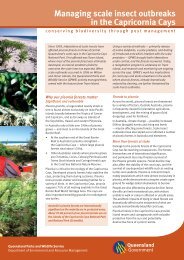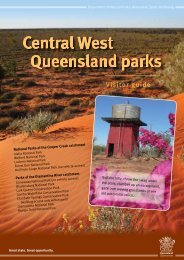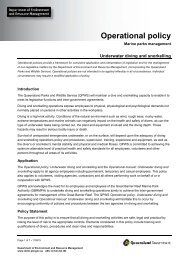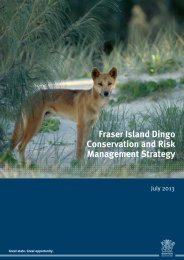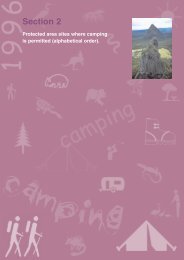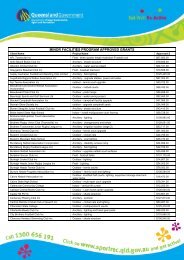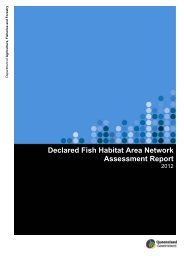Whitsunday and Mackay Islands Visitor Management Strategy ...
Whitsunday and Mackay Islands Visitor Management Strategy ...
Whitsunday and Mackay Islands Visitor Management Strategy ...
You also want an ePaper? Increase the reach of your titles
YUMPU automatically turns print PDFs into web optimized ePapers that Google loves.
<strong>Management</strong> strategies<br />
»<br />
»<br />
»<br />
Concentrate all facility development, <strong>and</strong> large vessel <strong>and</strong><br />
large group access at the southern end of Whitehaven Beach.<br />
Diversify visitor activities <strong>and</strong> spread the distribution of<br />
visitors by providing a walking trail to a lookout behind<br />
South Whitehaven Beach <strong>and</strong> a walking trail to Chance<br />
Bay as a part of the <strong>Whitsunday</strong> Isl<strong>and</strong>s Great Walk.<br />
Redevelop facilities to ensure camping <strong>and</strong> day-use areas<br />
are separated.<br />
6.4.2 Chance Bay, <strong>Whitsunday</strong> Isl<strong>and</strong><br />
Chance Bay is a low-key visitor site for most of the year.<br />
Facilities include a walking track leading from the beach to<br />
a small day-use <strong>and</strong> camping area (consisting of two tables<br />
<strong>and</strong> a rudimentary toilet). Kayakers occasionally use the site<br />
as a camping destination. The bay is exposed to prevailing<br />
south-east winds, often making it unsuitable for vessel<br />
anchorage. When northerlies blow, a large number of tour<br />
operators who would normally visit South Whitehaven Beach<br />
go to Chance Bay. It is allocated a high use setting as it<br />
becomes an alternative destination to Whitehaven in northerly<br />
winds. When consulted, a number of commercial tour<br />
operators requested a walking track from Chance Bay to<br />
South Whitehaven Beach.<br />
The dunes at Chance Bay show evidence of erosion, although<br />
how much visitor use contributes to this erosion is unknown.<br />
It is important to minimise visitor access to these dunes to<br />
reduce the likelihood of s<strong>and</strong> disturbance <strong>and</strong> further<br />
erosion. Weeds such as cobbler’s pegs <strong>and</strong> caltrop are present<br />
— these usually occur as a result of disturbance.<br />
<strong>Management</strong> strategies<br />
»<br />
»<br />
»<br />
Maintain commercial visitor use at current levels; any<br />
increase will not be sustainable.<br />
Develop Chance Bay as a trailhead for access to South<br />
Whitehaven Beach. This should reduce visitor density<br />
on the beach when the site is intensively used. The<br />
trailhead <strong>and</strong> walking track will be developed as a part<br />
of the <strong>Whitsunday</strong> Isl<strong>and</strong>s Great Walk.<br />
Redevelop facilities to ensure camping <strong>and</strong> day-use are<br />
separated. If there is a significant increase in day use of<br />
Chance Bay beach, evaluate the interaction between day<br />
users <strong>and</strong> campers. In the event that the two activities<br />
are determined to be incompatible, close Chance Bay as<br />
a camping area <strong>and</strong> manage for day-use only.<br />
6.4.3 Tongue Point, <strong>Whitsunday</strong> Isl<strong>and</strong><br />
After Whitehaven Beach, Tongue Point is the most popular<br />
visitor destination in the planning area. <strong>Visitor</strong>s to Tongue<br />
Point can walk along a short walking track of less than 1km<br />
to a lookout that provides world-class views of Hill Inlet, or<br />
down a boardwalk to Lookout Beach <strong>and</strong> Betty’s Beach.<br />
<strong>Visitor</strong>s often sun bake or play games on the beach. There is<br />
an information shelter at both Hill Inlet lookout <strong>and</strong><br />
Lookout Beach. Access to Tongue Point is via Tongue Bay<br />
where vessels moor or anchor <strong>and</strong> transfer visitors over a<br />
reef flat to a small beach. Alternatively, visitors can access<br />
the site via Betty’s Beach at the south-eastern end of Tongue<br />
Point. At low tide, access is difficult from both approaches.<br />
Facilities are inadequate for the current level of visitor use.<br />
Hill Inlet lookout is frequently crowded <strong>and</strong> long lines of<br />
visitors often have to wait for access. The walking track is<br />
regularly congested with lines of visitors who have been to<br />
the lookout squeezing past visitors who are still en-route.<br />
The site shows signs of visitor impact. The walking track to<br />
the lookout has many exposed tree roots, poor drainage <strong>and</strong><br />
evidence of litter <strong>and</strong> bush toileting. There has also been<br />
damage to the reef flat next to the access point in Tongue Bay.<br />
At Lookout Beach, it is clear that visitor disturbance is causing<br />
s<strong>and</strong> to move off the beach <strong>and</strong> cover existing facilities.<br />
<strong>Management</strong> strategies<br />
»<br />
»<br />
»<br />
»<br />
»<br />
»<br />
Until facilities are upgraded maintain commercial visitor<br />
use at June 2007 levels; any increase will not be<br />
sustainable. A moratorium on issuing any additional<br />
commercial activity permit capacity for the site will be<br />
introduced to implement this strategy.<br />
Work with GBRMPA to develop an integrated site plan<br />
for Tongue Point <strong>and</strong> Tongue Bay that explicitly<br />
encourages site access via Tongue Bay.<br />
Examine the feasibility of establishing all-tide access at<br />
Tongue Bay. Implementation would depend on<br />
obtaining funding through a public-private partnership.<br />
Consistent with the site plan, redevelop the walking<br />
track <strong>and</strong> lookout facilities to manage current visitor<br />
use. This will involve developing a loop track <strong>and</strong> toilet<br />
facilities, <strong>and</strong> establishing a second lookout.<br />
Minimise facility development <strong>and</strong> vessel access at Lookout<br />
Beach to keep this part of the site as natural as possible.<br />
Work with GBRMPA to keep Hill Inlet as natural as<br />
possible to preserve the view.<br />
Strategic directions<br />
19<br />
Table 6.4.2<br />
Current estimates of day use<br />
at Chance Bay, <strong>Whitsunday</strong> Isl<strong>and</strong><br />
<strong>Visitor</strong> type<br />
Commercial tour operator customers<br />
Free <strong>and</strong> independent travellers<br />
Estimate of<br />
annual day use<br />
10,000<br />
4000<br />
Total visits 14,000<br />
Table 6.4.3 Current estimates of day use<br />
at Tongue Point, <strong>Whitsunday</strong> Isl<strong>and</strong><br />
<strong>Visitor</strong> type<br />
Commercial tour operator customers<br />
Free <strong>and</strong> independent travellers<br />
Estimate of<br />
annual day use<br />
90,000<br />
40,000<br />
Total visits 130,000




